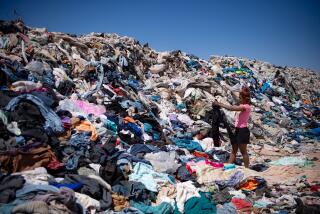PRACTICAL VIEW : Where Do All the Returns Go?
- Share via
Ever wonder what happened to that red sweater you took back because it wasn’t quite the right shade? Or to those too-tight shoes that the merchant more or less cheerfully let you return?
Some retailers’ no-questions-asked return policies raise questions about how new garments on the racks really are. A shopper can only hope to avoid the experience of one Los Angeles actress, who at the last minute bought an evening dress at a tony Rodeo Drive boutique, only to get it home and find perspiration stains.
Last month, an investigation by the Oregon attorney general focused on Nordstrom’s return policies. Several store employees alleged in affidavits that the retailer had asked them to wear clothes for sales and promotions and to put the items back on the rack. Scuffed shoes were sanded and stained to appear new, the employees alleged.
In agreeing to pay the state a $25,000 settlement, Seattle-based Nordstrom did not admit any wrongdoing. Spokesman Tim Doke said the retailer viewed the accusations as “totally without merit.”
Like many other retailers, Doke said, Nordstrom marks used or worn clothing “out of stock” and writes it off as a loss. If returned merchandise is in “like new” condition but has a flaw, such as a small tear, Nordstrom marks it down and sends it to one of its 12 Rack discount outlets, with an “As Is” label. Occasionally, slightly damaged shoes will be refurbished and sold at the Rack, also clearly labeled “As Is.”
In Anaheim, Nordstrom operates a 6,000-square-foot, unmarked warehouse where employees do nothing but determine what to do with piles of returned merchandise.
Worn, damaged or soiled garments are sold for $2 to $2.25 each to “jobbers,” who in turn sell them to Goodwill or discount stores. Any lingerie or swimwear is marked “out of stock” and shredded for sanitary reasons. And many retailers have deals with manufacturers that allow them to return garments for credit.
Doke noted that Nordstrom makes one exception to its liberal policy: Special-occasion dresses must be returned with tags intact, to avoid the “rent-a-dress phenomenon.”
At cataloguer Lands’ End, most merchandise comes back because of color or size problems, said spokeswoman Charlotte LaComb. Anything a customer has tried on is inspected for damage or dirt. If it passes muster, it goes back into inventory for resale.
Of the merchandise returned, LaComb said, about 76% is suitable for resale; 15% goes to the company’s 11 outlet stores, where it is labeled “Not Quite Perfect”; 7% is donated to charity, and about 1% is returned to manufacturers.
More to Read
Inside the business of entertainment
The Wide Shot brings you news, analysis and insights on everything from streaming wars to production — and what it all means for the future.
You may occasionally receive promotional content from the Los Angeles Times.











